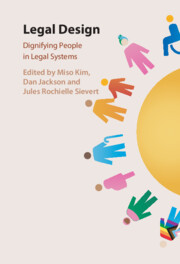Book contents
- Legal Design
- Legal Design
- Copyright page
- Dedication
- Contents
- Figures and Tables
- Contributors
- Foreword
- Acknowledgments
- Introduction
- I Why Legal Design
- II What Legal Design Can Do
- III How Legal Design Works
- 12 Designers, Lawyers, and Students
- 13 Teaching the Legal Inventors of the Future
- 14 The Stanford Legal Design Lab
- 15 Graphically Novel
- 16 Building Technology with(out) People
- 17 International Courts and Design
- 18 James v Birnmann
- 19 The ReInvent Law Archive
- 20 The Open Law Lab Blog
- 21 Disciplinarity and the Modes of Legal Design
- IV Where Legal Design Goes
- Conclusion
- Index
- References
18 - James v Birnmann
The Potential of Critical Design for Examining Legal Issues
from III - How Legal Design Works
Published online by Cambridge University Press: 19 December 2024
- Legal Design
- Legal Design
- Copyright page
- Dedication
- Contents
- Figures and Tables
- Contributors
- Foreword
- Acknowledgments
- Introduction
- I Why Legal Design
- II What Legal Design Can Do
- III How Legal Design Works
- 12 Designers, Lawyers, and Students
- 13 Teaching the Legal Inventors of the Future
- 14 The Stanford Legal Design Lab
- 15 Graphically Novel
- 16 Building Technology with(out) People
- 17 International Courts and Design
- 18 James v Birnmann
- 19 The ReInvent Law Archive
- 20 The Open Law Lab Blog
- 21 Disciplinarity and the Modes of Legal Design
- IV Where Legal Design Goes
- Conclusion
- Index
- References
Summary
The growing field of legal design has largely adopted a design-thinking approach. Whilst this has improved efficiency and usability within legal systems, it has insufficiently addressed its systemic issues and in some cases has further entrenched such issues. Critical Design opposes the affirmative approach of design-thinking; it uses design as a method for finding and expanding problems rather than solving them quickly and discreetly. A Critical Design perspective applied to legal issues has the potential to more fundamentally interrogate systemic legal issues, which is necessary for creating a fairer legal system. The project James v Birnmann illustrates the capacity for Critical Design to contend with legal issues. Through utilising popular aesthetics and media, James v Birnmann engages the public with the negative impacts of the growing mediatisation of courtroom trials and the use of AI within legal processes. Challenging the public’s perception of law in this way is a useful step towards legal reform in-unto-itself, whilst this problem-finding approach could also work alongside and enrich the more solution-driven legal design as it is currently practised.
Keywords
- Type
- Chapter
- Information
- Legal DesignDignifying People in Legal Systems, pp. 278 - 305Publisher: Cambridge University PressPrint publication year: 2024

